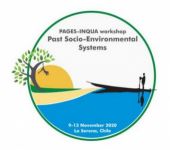The Spotlight #7
Posted by Francesca Ferrario in ECR News on 19 May 2022
Today we move to South America, to dive into Argentinian lakes! The Quaternary International paper highlighted this month is led by Carina Seitz and is entitled “Response of shallow lakes in the arid-semiarid Pampas of Argentina to Late Holocene hydroclimatic change”.
The research
Four Pampean shallow lakes (Figure 1), located in a zone of transition between arid and semi-arid climate conditions, were analyzed to reconstruct their evolution in the last millennia. The principal aim of the research is to identify the factors and climatic mechanisms that ruled the long-term ecological change. The methods include analysis of diatoms and phytoliths, collected from sediment cores retrieved from the deepest part of each lake.

Figure 1: a) location of the study area, Google Earth imagery; b-e) the four studied lakes; the red circle is the location of coring sites.
The results highlight an evolution from temporary clear lakes toward permanent lakes with turbid waters (Figure 2). A general decrease in depositional energy is testified by the change from gravel or sand to finer sediments toward the top of the cores. Also, stressful conditions in the early part of the records are inferred from the dominance of the motile diatoms and phytoliths; meanwhile, the top increase in water level is inferred from the domination of planktonic diatoms and low proportion of phytoliths. The authors suggest that the driving mechanism for ecological changes is related to an increase in the amount of precipitation, which resulted in higher lake levels. Other environmental factors influencing the local ecological setting and water salinity and nutrient load.

Figure 2: Comparison of the limnological pattern of variability in the four studied lakes, against regional factors of climatic change.
Why should we care?
Water is the most fundamental resource for life on Earth. The availability of water resources depends on the pattern of precipitation, which is expected to be subjected to modification under global warming conditions. The response of water bodies to such changes includes complex interdependencies; this is particularly true in arid and semi-arid regions: these settings are of particular concern and previous research in Pampean lakes have recognized their sensitivity to past climates. The recognition of phases with temporary lakes and permanent lakes and a thorough understanding of the mechanisms behind Quaternary hydroclimatic variability will be useful for a sustainable management of water resources.
The Author
Carina Seitz is a postdoctoral researcher at the Instituto Argentino de Oceanografía (CONICET-UNS). She is in the process of admission as an assistant researcher at CONICET, working in the Universidad Nacional del Comahue. She finished her Ph.D. in 2009, and this research is part of her Ph.D. Her research interest is to understand the response of lakes to extraordinary events due to extreme geological, climatic, and anthropic events. She actively participates in the project pSESYNTH funded by INQUA, Past socio-environmental systems virtual workshop, and get-together talks.
E-mail address: carina.seitz6ATgmailDOTcom
ResearchGate profile: https://www.researchgate.net/profile/Carina_Seitz2
Post written by Francesca Ferrario, Terpro ECR Representative.




